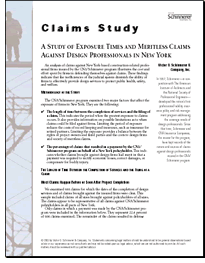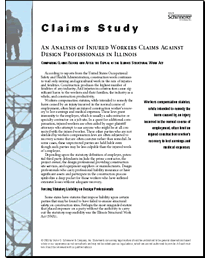

Research Reveals a Truer Picture of Liability Claims
Two studies of New York and Illinois provide a gauge of what kinds of professional liability claims are being filed and at what frequency in those states. The findings, developed by Victor O. Schinnerer & Co., serve as factual background for AIA New York State and AIA Illinois, who requested them. Supporting the state-component lobbying efforts, the studies illustrate, among other things, the low incidence of claims in New York more than seven years after substantial completion and the dramatic drop in costly but unsubstantiated claims following the repeal in Illinois of a law allowing construction-worker lawsuits against architects.
New York study results
 Only
1.3 percent of claims filed against New York design professionals occurred
more than seven years following the substantial completion of construction
projects for which services were provided. This is based on a study
of a 664-claim sample.
Only
1.3 percent of claims filed against New York design professionals occurred
more than seven years following the substantial completion of construction
projects for which services were provided. This is based on a study
of a 664-claim sample.- Only 17.8 percent of claims filed against New York design professionals resulted in the CNA/Schinnerer program having to make indemnity payments on their behalf. This is based on a five-year study of all claims in New York against our policyholders.
“We think the study speaks to the need for an effective statute of repose in New York and for action to reduce the meritless claims brought against design professionals,” says Frank Musica, Assoc. AIA, risk management attorney for Schinnerer.
Illinois study results
This study examines injured worker claims during a five-year period before
the repeal of the Illinois Structural Work Act and during a five-year
period starting the year after the act's repeal.
 When
the Structural Work Act was in place, about 36 percent of claims brought
against our policyholders in Illinois were injured worker claims. Following
its repeal, only about 12 percent of the claims were injured worker
claims. Nationally, the average is about 8 percent of claims.
When
the Structural Work Act was in place, about 36 percent of claims brought
against our policyholders in Illinois were injured worker claims. Following
its repeal, only about 12 percent of the claims were injured worker
claims. Nationally, the average is about 8 percent of claims.- Only about 10 percent of injured worker claims resulted in any insurance company payment. The other 90 percent, however, drained the professional service firms of productive time and money and increased insurance defense costs. These expenses to insured firms had to be internalized resulting in increased costs and decreased productivity.
“Clearly,” Musica states, “the Illinois Structural Work Act provided very little in payments by insured firms to injured workers but caused major expenses to professional service firms, their insurers, and the public and private clients of the firms forced to defend themselves.”
Copyright 2003 The American Institute of Architects.
All rights reserved. Home Page ![]()
![]()
 |
||
| Click here to see the New York study report (86K PDF). Click here to see the Illinois study report (155K PDF). For more information about Victor O. Schinnerer & Co., the
AIA/NSPE commended profession liability carrier, visit their Web
site.
|
||